Simulating Sundowner Winds in Coastal Santa Barbara: Model Validation and Sensitivity
Abstract
1. Introduction
2. Data and Methods
2.1. Observations
2.2. Model Setup and Sensitivity Experiments
2.3. Verification Strategy & Limitations
3. Case Studies
4. Model Skill
4.1. Winds, Temperature, and Humidity
4.2. Spatial Distribution of Winds
5. 11–12 March 2017 Sundowner Event
5.1. Comparison with Surface Wind Observations
5.2. Variability of Surface Winds and PBL Height
5.3. Along-Slope Vertical Wind Profiles and Jet Behavior
5.4. Erosion of the Marine Layer
5.5. Surface Wind Fields along the SYM
6. Conclusions
Supplementary Materials
Author Contributions
Funding
Acknowledgments
Conflicts of Interest
Abbreviations
| PBL | Planetary Boundary Layer |
| LSM | Land Surface Model |
| TKE | Turbulent Kinetic Energy |
| SYM | Santa Ynez Mountains |
| SBC | Coastal Santa Barbara |
| WRF | Weather Research and Forecasting |
| agl | above ground level |
| NWS | National Weather Service |
| RAWS | Remote Automated Weather Stations |
| SBCAPCD | Santa Barbara County Air Pollution Control District |
| NOAA | National Oceanic & Atmospheric Administration |
| ESRL | Earth System Research Laboratory |
| KSBA | Santa Barbara Municipal Airport |
| ERA | European Centre for Medium-Range Weather Forecasts Re-Analysis |
| USGS | United States Geological Survey |
| RRTMG | Rapid Radiative Transfer Model for General Circulation Models |
| YSU | Yonsei University |
| ACM2 | Asymmetric Convection Model version 2 |
| MYJ | Mellor-Yamada-Janjic |
| MYNN2.5 | Mellor-Yamada-Nakanishi-Niino level 2.5 |
| QNSE | Quasi-Normale Scale Elimination |
| PX | Pleim-Xiu |
| TD | 5-layer Thermal Diffusion |
| RUC | Rapid Update Cycle |
| MBE | Mean Bias Error |
| MAE | Mean Absolute Error |
| RMSE | Root Mean Square Error |
| NWS LOX | National Weather Serivce Forecast Office Los Angeles |
| PST | Pacific Standard Time |
| MTIC1 | Montecito hills station |
| msl | mean sea level |
| RHWC1 | Refugio station |
| MPWC1 | San Marcos pass station |
| SBVC1 | Santa Barbara Botanic Garden station |
| MOIC1 | Montecito foothills station |
References
- Blier, W. The sundowner winds of Santa Barbara, California. Wea. Forecast. 1998, 13, 702–716. [Google Scholar] [CrossRef]
- Sukup, S. Extreme Northeasterly Wind Events in the Hills Above Montecito, California; Western Region Technical Attachment NWS WR-1302; National Weather Service Western Region: Salt Lake City, UT, USA, 2013. [Google Scholar]
- Ryan, G. Downslope Winds of Santa Barbara, California; NEXRAD Weather Service Forecast Office: Oxnard, CA, USA, 1996. [Google Scholar]
- Cannon, F.; Carvalho, L.M.; Jones, C.; Hall, T.; Gomberg, D.; Dumas, J.; Jackson, M. WRF simulation of downslope wind events in coastal Santa Barbara County. Atmos. Res. 2017, 191, 57–73. [Google Scholar] [CrossRef]
- Smith, C.; Hatchett, B.; Kaplan, M. Characteristics of Sundowner Winds Near Santa Barbara, CA, From a Dynamically Downscaled Climatology: Environment and Effects Aloft and Offshore. J. Geophys. Res.-Atmos. 2018, 123, 13092–13110. [Google Scholar] [CrossRef]
- Brinkmann, W.A. Strong downslope winds at Boulder, Colorado. Mon. Weather Rev. 1974, 102, 592–602. [Google Scholar] [CrossRef]
- Jiang, Q.; Doyle, J.D. Gravity wave breaking over the central Alps: Role of complex terrain. J. Atmos. Sci. 2004, 61, 2249–2266. [Google Scholar] [CrossRef]
- Grisogono, B.; Belušić, D. A review of recent advances in understanding the meso and microscale properties of the severe Bora wind. Tellus A 2009, 61, 1–16. [Google Scholar] [CrossRef]
- Hughes, M.; Hall, A. Local and synoptic mechanisms causing Southern California’s Santa Ana winds. Clim. Dynam. 2010, 34, 847–857. [Google Scholar] [CrossRef]
- Cao, Y.; Fovell, R.G. Downslope windstorms of San Diego County. Part I: A case study. Mon. Weather Rev. 2016, 144, 529–552. [Google Scholar] [CrossRef]
- Scorer, R. Theory of waves in the lee of mountains. Q. J. R. Meteorol. Soc. 1949, 75, 41–56. [Google Scholar] [CrossRef]
- Grubišić, V.; Billings, B.J. The intense lee-wave rotor event of Sierra Rotors IOP 8. J. Atmos. Sci. 2007, 64, 4178–4201. [Google Scholar] [CrossRef]
- Vosper, S. Inversion effects on mountain lee waves. Q. J. R. Meteorol. Soc. 2004, 130, 1723–1748. [Google Scholar] [CrossRef]
- Durran, D.R. Mountain waves and downslope winds. In Atmospheric Processes over Complex Terrain; Springer: Berlin, Germany, 1990; pp. 59–81. [Google Scholar]
- Clark, T.; Peltier, W. On the evolution and stability of finite-amplitude mountain waves. J. Atmos. Sci. 1977, 34, 1715–1730. [Google Scholar] [CrossRef]
- Hatchett, B.J.; Smith, C.M.; Nauslar, N.J.; Kaplan, M.L. Brief Communication: Synoptic-scale differences between Sundowner and Santa Ana wind regimes in the Santa Ynez Mountains, California. Nat. Hazard. Earth Syst. 2018, 18, 419. [Google Scholar] [CrossRef]
- Smith, C.M.; Hatchett, B.J.; Kaplan, M.L. Characteristics of Sundowner Winds near Santa Barbara, California, from a Dynamically Downscaled Climatology: Environment and Effects near the Surface. J. Appl. Meteorol. Clim. 2018, 57, 589–606. [Google Scholar] [CrossRef]
- Skamarock, W.C.; Klemp, J.B. A time-split nonhydrostatic atmospheric model for weather research and forecasting applications. J. Comput. Phys. 2008, 227, 3465–3485. [Google Scholar] [CrossRef]
- Udina, M.; Soler, M.R.; Sol, O. A modeling study of a trapped lee-wave event over the Pyrénées. Mon. Weather Rev. 2017, 145, 75–96. [Google Scholar] [CrossRef]
- Richard, E.; Mascart, P.; Nickerson, E.C. The role of surface friction in downslope windstorms. J. Appl. Meteorol. 1989, 28, 241–251. [Google Scholar] [CrossRef]
- Jonassen, M.O.; Ágústsson, H.; Ólafsson, H. Impact of surface characteristics on flow over a mesoscale mountain. Q. J. R. Meteorol. Soc. 2014, 140, 2330–2341. [Google Scholar] [CrossRef]
- Cao, Y.; Fovell, R.G. Downslope windstorms of San Diego County. Part II: Physics ensemble analyses and gust forecasting. Weather Forecast. 2018, 133, 539–559. [Google Scholar] [CrossRef]
- Pattantyus, A.K.; Chiao, S.; Czyzyk, S. Improving high-resolution model forecasts of downslope winds in the Las Vegas Valley. J. Appl. Meteorol. Clim. 2011, 50, 1324–1340. [Google Scholar] [CrossRef]
- Muñoz-Esparza, D.; Sauer, J.A.; Linn, R.R.; Kosović, B. Limitations of one-dimensional mesoscale PBL parameterizations in reproducing mountain-wave flows. J. Atmos. Sci. 2016, 73, 2603–2614. [Google Scholar] [CrossRef]
- Grubišić, V.; Serafin, S.; Strauss, L.; Haimov, S.J.; French, J.R.; Oolman, L.D. Wave-induced boundary layer separation in the lee of the Medicine Bow Mountains. Part II: Numerical modeling. J. Atmos. Sci. 2015, 72, 4865–4884. [Google Scholar] [CrossRef]
- Horel, J.; Splitt, M.; Dunn, L.; Pechmann, J.; White, B.; Ciliberti, C.; Lazarus, S.; Slemmer, J.; Zaff, D.; Burks, J. Mesowest: Cooperative mesonets in the western United States. Bull. Am. Meteorol. Soc. 2002, 83, 211–226. [Google Scholar] [CrossRef]
- National Wildfire Coordinating Group. Interagency Wildland Fire Weather Station Standards & Guidelines; National Wildfire Coordinating Group: Boise, ID, USA, 2014; Volume PMS 426-3, 55p. [Google Scholar]
- Dee, D.P.; Uppala, S.M.; Simmons, A.; Berrisford, P.; Poli, P.; Kobayashi, S.; Andrae, U.; Balmaseda, M.; Balsamo, G.; Bauer, d.P.; et al. The ERA-Interim reanalysis: Configuration and performance of the data assimilation system. Q. J. R. Meteorol. Soc. 2011, 137, 553–597. [Google Scholar] [CrossRef]
- Thompson, G.; Rasmussen, R.M.; Manning, K. Explicit forecasts of winter precipitation using an improved bulk microphysics scheme. Part I: Description and sensitivity analysis. Mon. Weather Rev. 2004, 132, 519–542. [Google Scholar] [CrossRef]
- Iacono, M.J.; Delamere, J.S.; Mlawer, E.J.; Shephard, M.W.; Clough, S.A.; Collins, W.D. Radiative forcing by long-lived greenhouse gases: Calculations with the AER radiative transfer models. J. Geophys. Res.-Atmos. 2008, 113. [Google Scholar] [CrossRef]
- Tiedtke, M. A comprehensive mass flux scheme for cumulus parameterization in large-scale models. Mon. Weather Rev. 1989, 117, 1779–1800. [Google Scholar] [CrossRef]
- Zhang, C.; Wang, Y.; Hamilton, K. Improved representation of boundary layer clouds over the southeast Pacific in ARW-WRF using a modified Tiedtke cumulus parameterization scheme. Mon. Weather Rev. 2011, 139, 3489–3513. [Google Scholar] [CrossRef]
- Hong, S.Y.; Noh, Y.; Dudhia, J. A new vertical diffusion package with an explicit treatment of entrainment processes. Mon. Weather Rev. 2006, 134, 2318–2341. [Google Scholar] [CrossRef]
- Pleim, J.E. A combined local and nonlocal closure model for the atmospheric boundary layer. Part I: Model description and testing. J. Appl. Meteorol. Clim. 2007, 46, 1383–1395. [Google Scholar] [CrossRef]
- Mellor, G.L.; Yamada, T. Development of a turbulence closure model for geophysical fluid problems. Rev. Geophys. 1982, 20, 851–875. [Google Scholar] [CrossRef]
- Nakanishi, M.; Niino, H. An improved Mellor–Yamada level-3 model: Its numerical stability and application to a regional prediction of advection fog. Bound.-Layer Meteorol. 2006, 119, 397–407. [Google Scholar] [CrossRef]
- Sukoriansky, S.; Galperin, B.; Perov, V. Application of a new spectral theory of stably stratified turbulence to the atmospheric boundary layer over sea ice. Bound.-Layer Meteorol. 2005, 117, 231–257. [Google Scholar] [CrossRef]
- Pleim, J.E.; Xiu, A. Development and testing of a surface flux and planetary boundary layer model for application in mesoscale models. J. Appl. Meteorol. 1995, 34, 16–32. [Google Scholar] [CrossRef]
- Tewari, M.; Chen, F.; Wang, W.; Dudhia, J.; LeMone, M.; Mitchell, K.; Ek, M.; Gayno, G.; Wegiel, J.; Cuenca, R. Implementation and verification of the unified NOAH land surface model in the WRF model. In Proceedings of the 20th Conference on Weather Analysis and Forecasting/16th Conference on Numerical Weather Prediction, Seattle, WA, USA, 10–12 January 2004; pp. 11–15. [Google Scholar]
- Dudhia, J. A multi-layer soil temperature model for MM5. In Proceedings of the Sixth PSU/NCAR Mesoscale Model Users’ Workshop, Boulder CO, USA, 22–24 July 1996; pp. 22–24. [Google Scholar]
- Benjamin, S.G.; Grell, G.A.; Brown, J.M.; Smirnova, T.G.; Bleck, R. Mesoscale weather prediction with the RUC hybrid isentropic–terrain-following coordinate model. Mon. Weather Rev. 2004, 132, 473–494. [Google Scholar] [CrossRef]
- Kalverla, P.; Duine, G.J.; Steeneveld, G.J.; Hedde, T. Evaluation of the Weather Research and Forecasting model for contrasting diurnal cycles in the Durance Valley complex terrain during the KASCADE field campaign. J. Appl. Meteorol. Clim. 2016, 55, 861–882. [Google Scholar] [CrossRef]
- Mass, C.; Ovens, D. Fixing WRF’s high speed wind bias: A new subgrid scale drag parameterization and the role of detailed verification. In Proceedings of the 24th Conference on Weather and Forecasting and 20th Conference on Numerical Weather Prediction, Preprints, 91st American Meteorological Society Annual Meeting, Seattle, WA, USA, 23–27 January 2011; Volume 23727. [Google Scholar]
- Jiménez, P.A.; Dudhia, J. Improving the representation of resolved and unresolved topographic effects on surface wind in the WRF model. J. Appl. Meteorol. Climatol. 2012, 51, 300–316. [Google Scholar] [CrossRef]
- Fovell, R.G.; Gallagher, A. Winds and Gusts during the Thomas Fire. Fire 2018, 1, 47. [Google Scholar] [CrossRef]
- Nielsen-Gammon, J.W.; Powell, C.L.; Mahoney, M.J.; Angevine, W.M.; Senff, C.; White, A.; Berkowitz, C.; Doran, C.; Knupp, K. Multisensor estimation of mixing heights over a coastal city. J. Appl. Meteorol. Clim. 2008, 47, 27–43. [Google Scholar] [CrossRef]
- LeMone, M.A.; Tewari, M.; Chen, F.; Dudhia, J. Objectively determined fair-weather CBL depths in the ARW-WRF model and their comparison to CASES-97 observations. Mon. Weather Rev. 2013, 141, 30–54. [Google Scholar] [CrossRef]
- Clark, T.; Peltier, W. Critical level reflection and the resonant growth of nonlinear mountain waves. J. Atmos. Sci. 1984, 41, 3122–3134. [Google Scholar] [CrossRef]
- Kleczek, M.A.; Steeneveld, G.J.; Holtslag, A.A. Evaluation of the weather research and forecasting mesoscale model for GABLS3: Impact of boundary-layer schemes, boundary conditions and spin-up. Bound.-Layer Meteorol. 2014, 152, 213–243. [Google Scholar] [CrossRef]
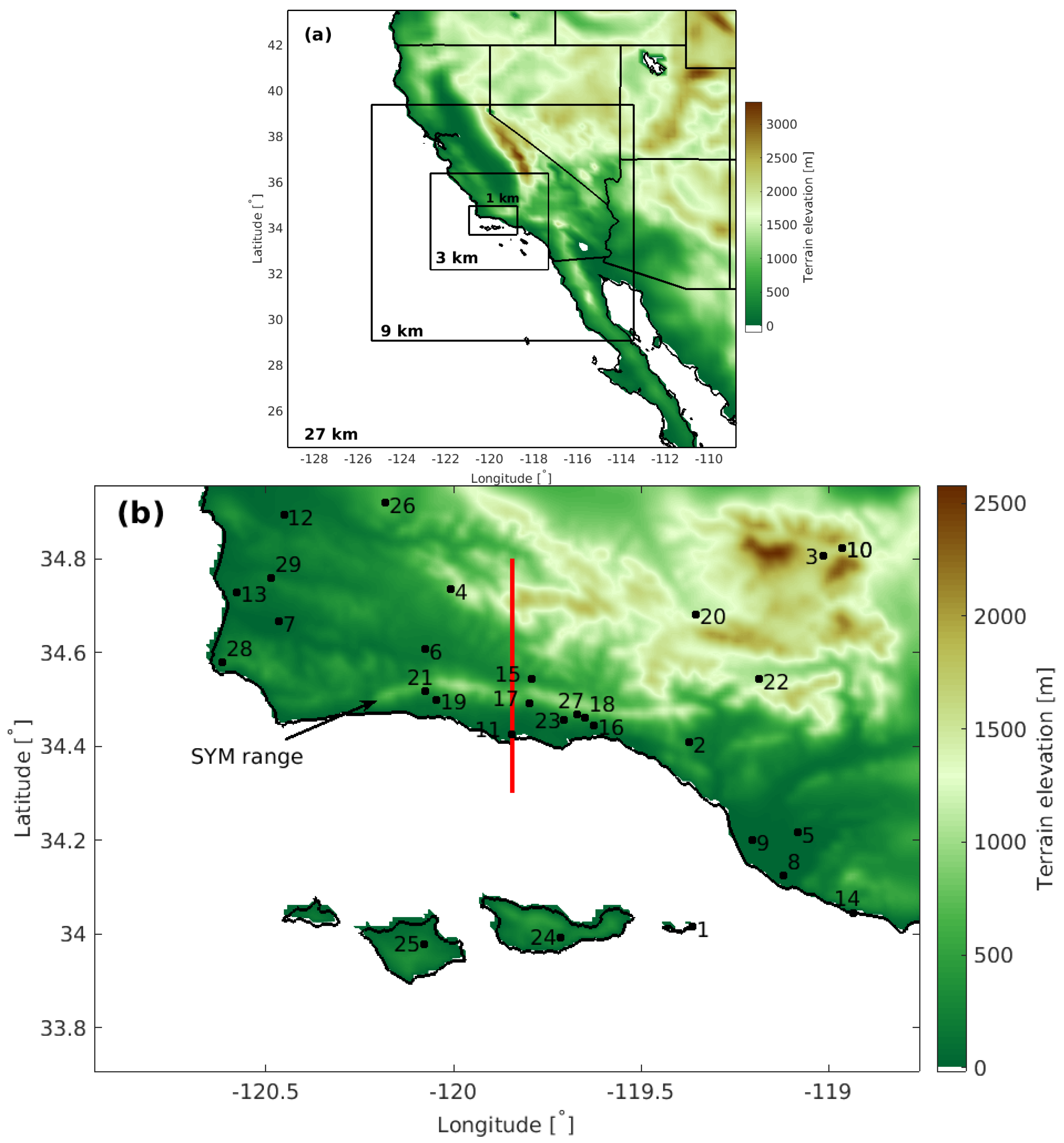
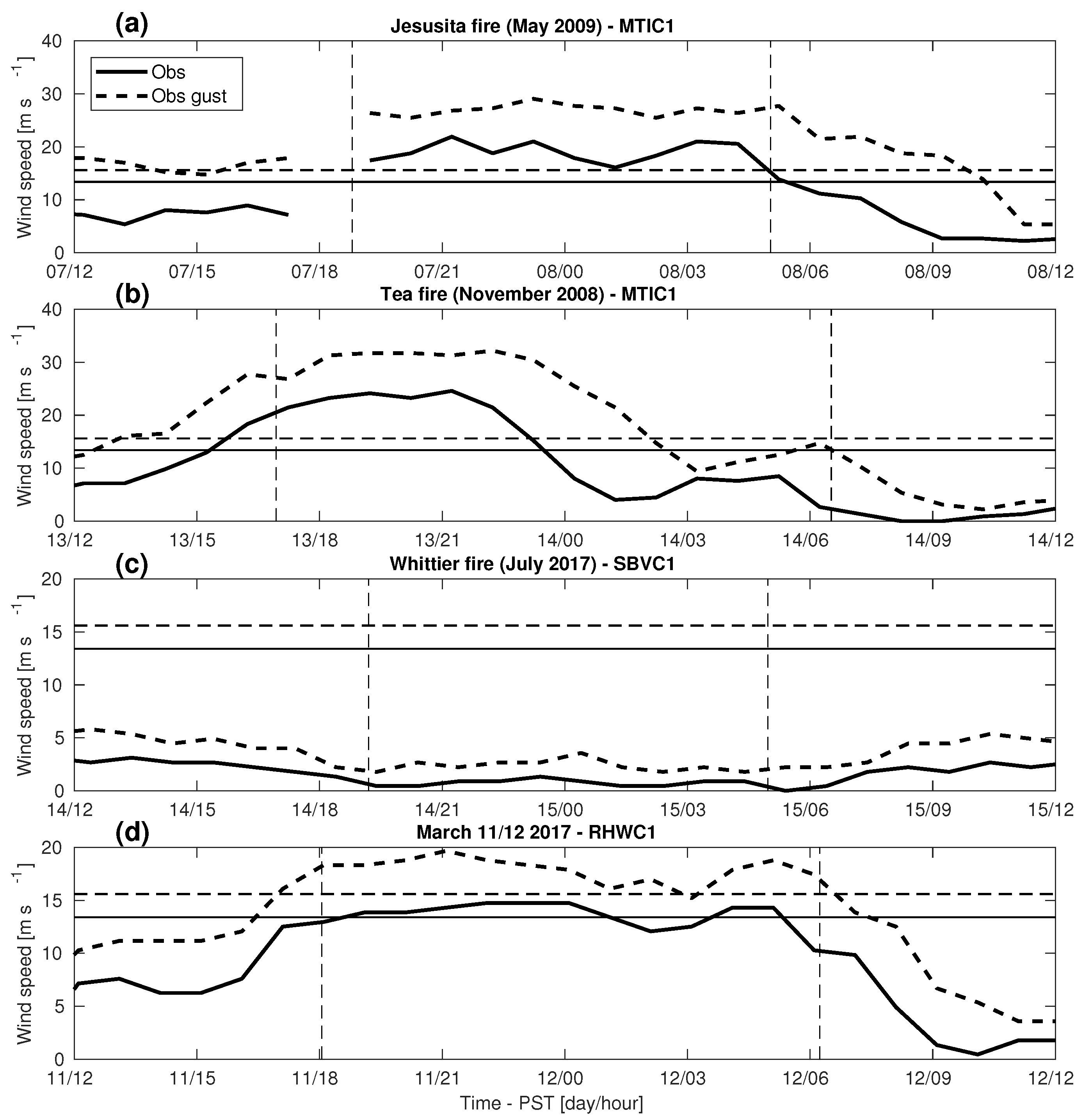
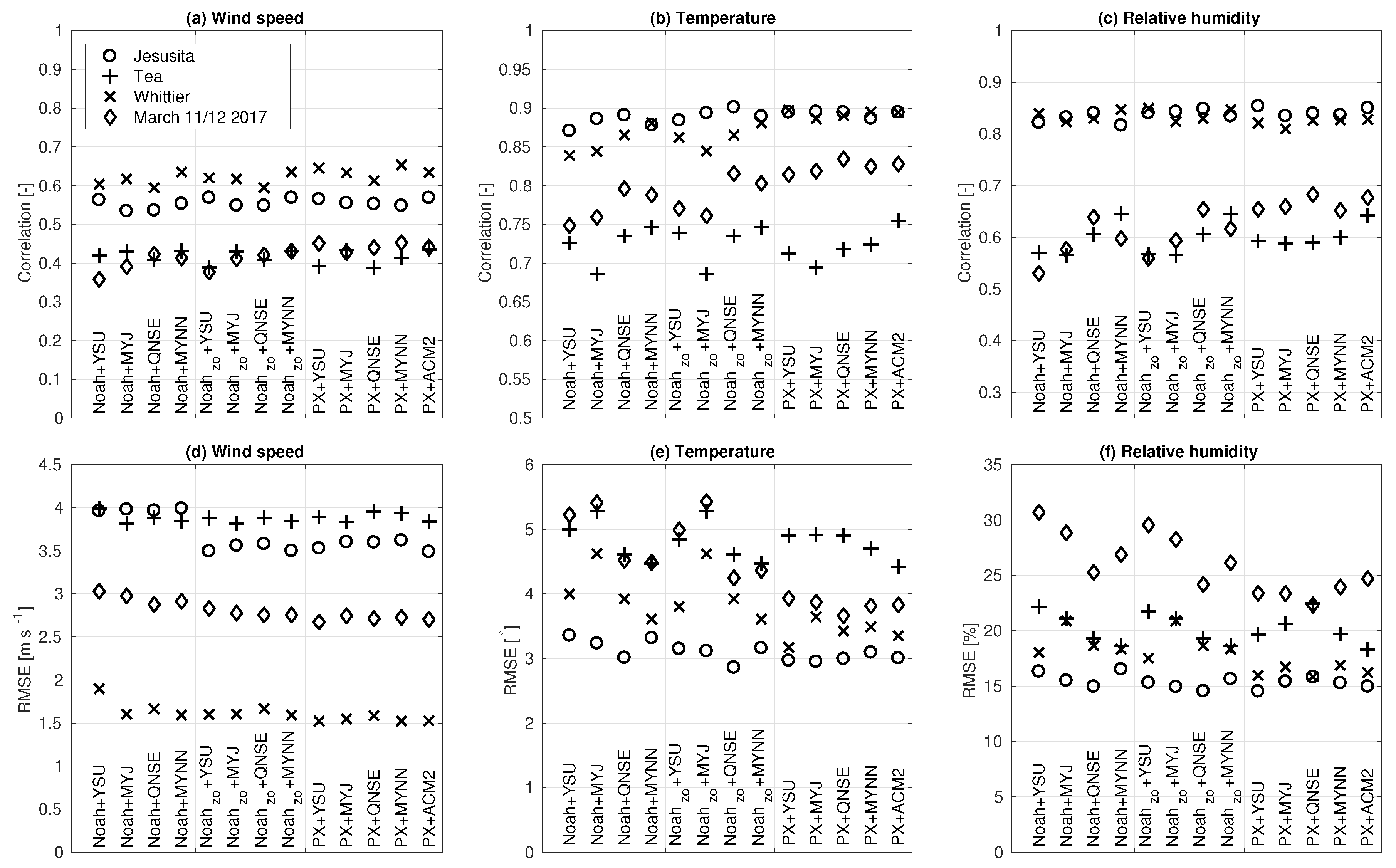
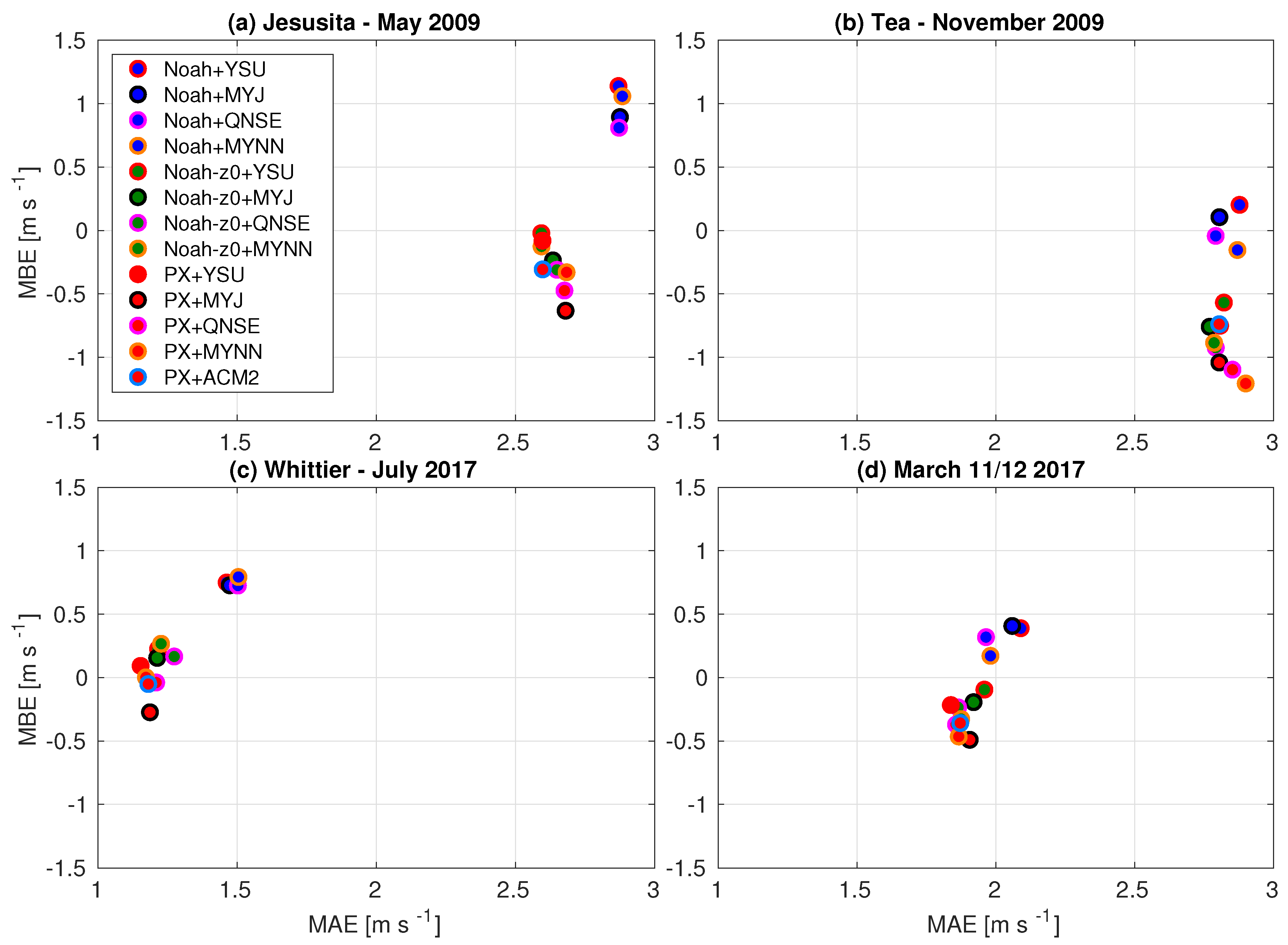
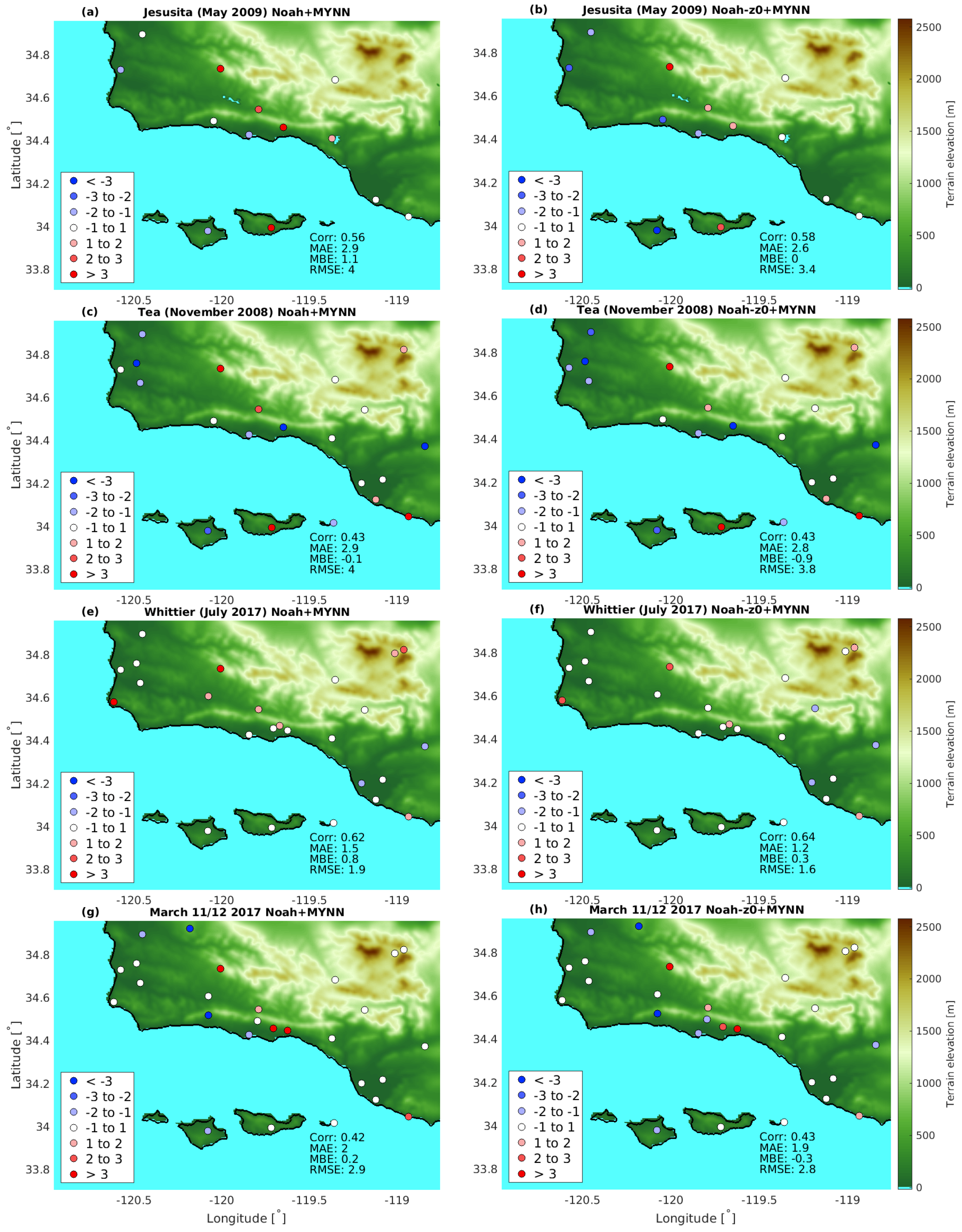
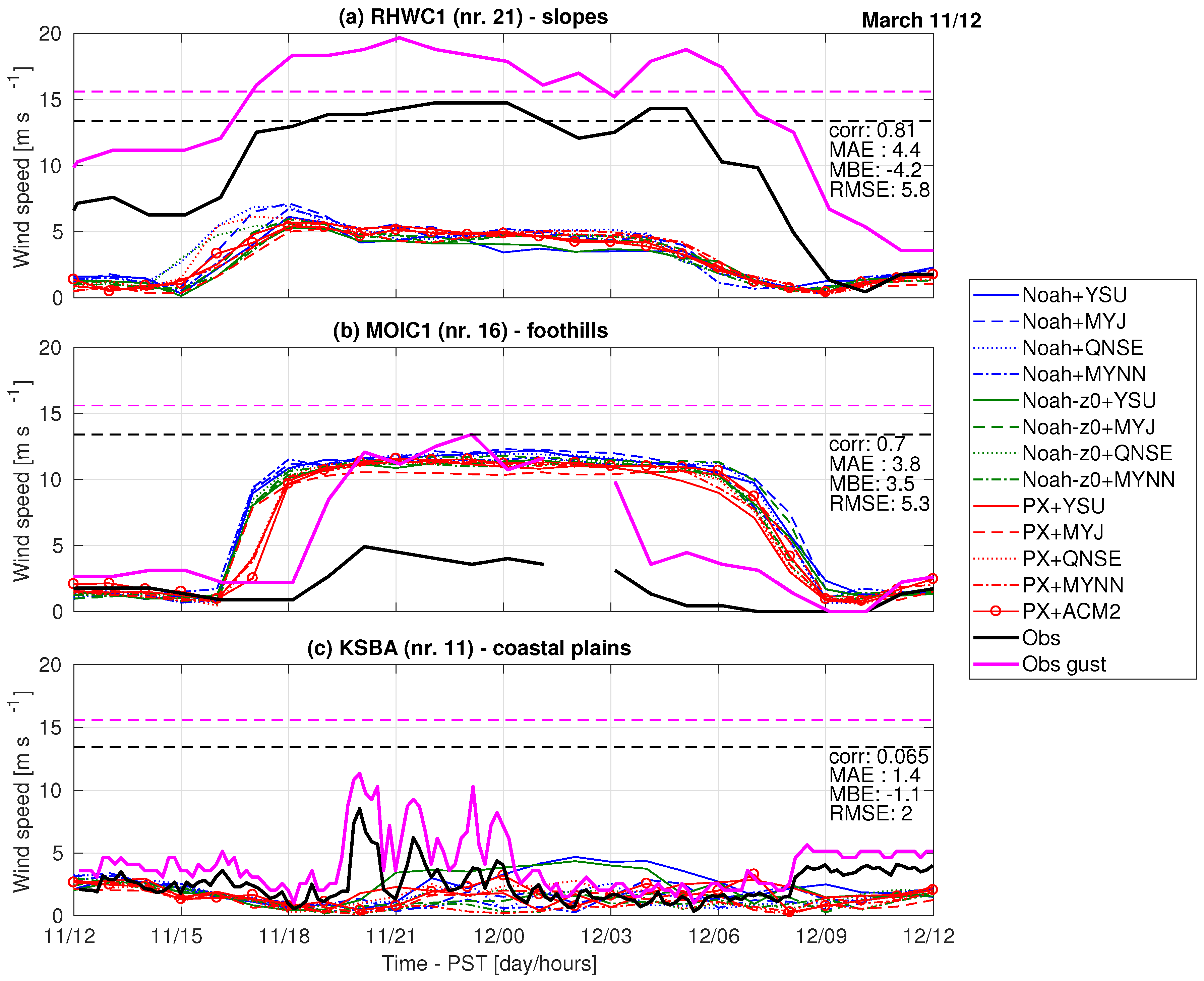
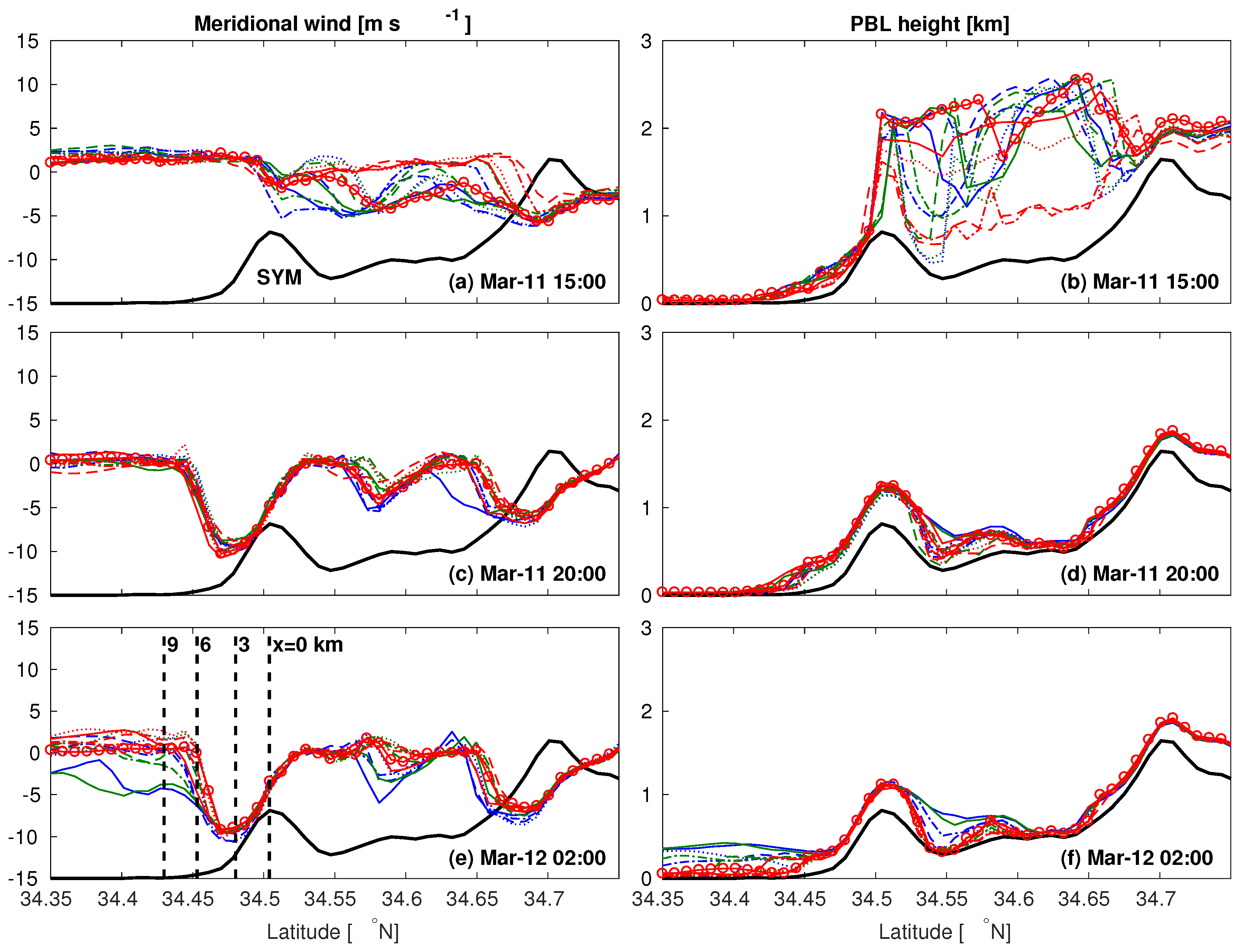
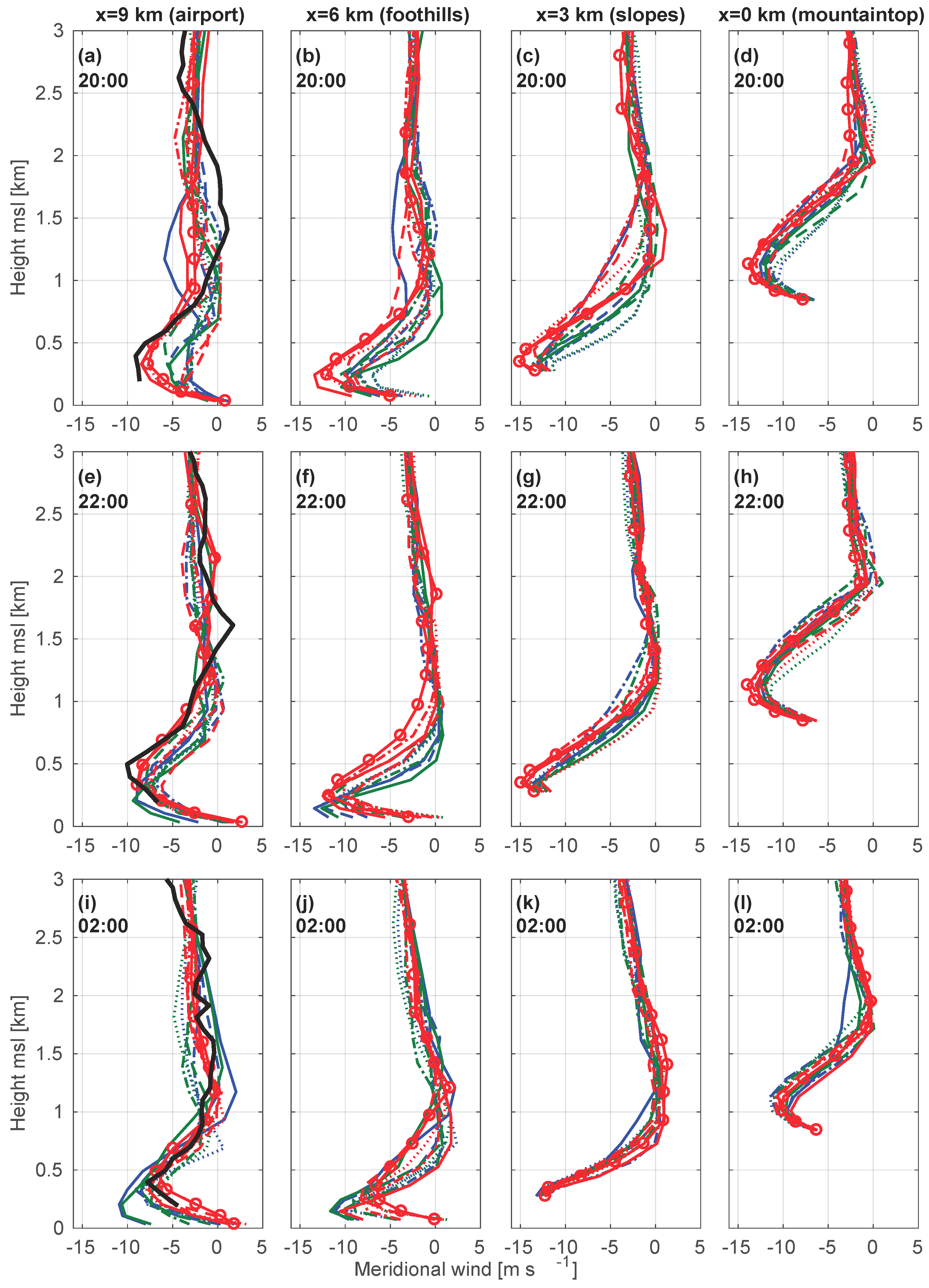

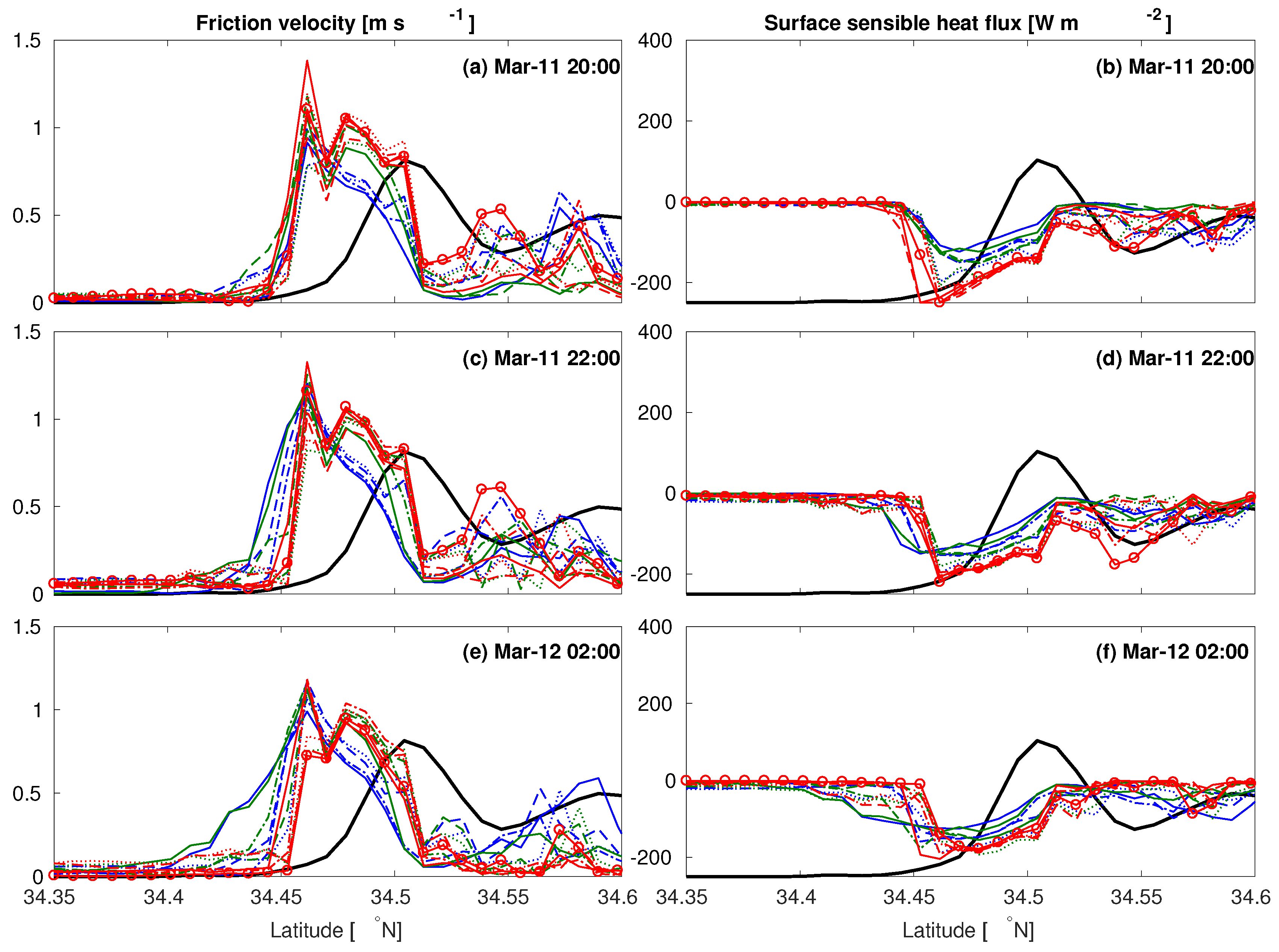
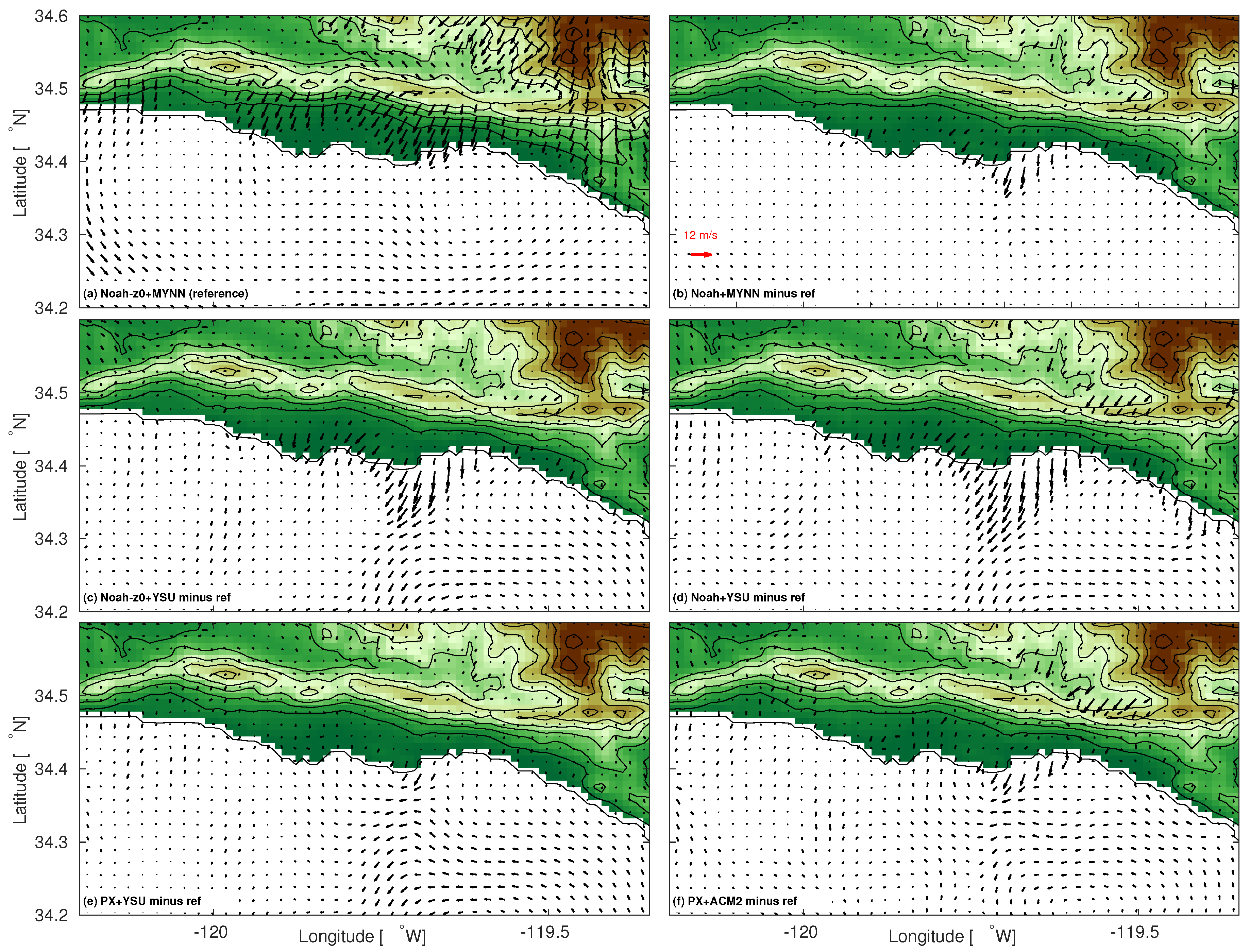
© 2019 by the authors. Licensee MDPI, Basel, Switzerland. This article is an open access article distributed under the terms and conditions of the Creative Commons Attribution (CC BY) license (http://creativecommons.org/licenses/by/4.0/).
Share and Cite
Duine, G.-J.; Jones, C.; Carvalho, L.M.V.; Fovell, R.G. Simulating Sundowner Winds in Coastal Santa Barbara: Model Validation and Sensitivity. Atmosphere 2019, 10, 155. https://doi.org/10.3390/atmos10030155
Duine G-J, Jones C, Carvalho LMV, Fovell RG. Simulating Sundowner Winds in Coastal Santa Barbara: Model Validation and Sensitivity. Atmosphere. 2019; 10(3):155. https://doi.org/10.3390/atmos10030155
Chicago/Turabian StyleDuine, Gert-Jan, Charles Jones, Leila M.V. Carvalho, and Robert G. Fovell. 2019. "Simulating Sundowner Winds in Coastal Santa Barbara: Model Validation and Sensitivity" Atmosphere 10, no. 3: 155. https://doi.org/10.3390/atmos10030155
APA StyleDuine, G.-J., Jones, C., Carvalho, L. M. V., & Fovell, R. G. (2019). Simulating Sundowner Winds in Coastal Santa Barbara: Model Validation and Sensitivity. Atmosphere, 10(3), 155. https://doi.org/10.3390/atmos10030155






